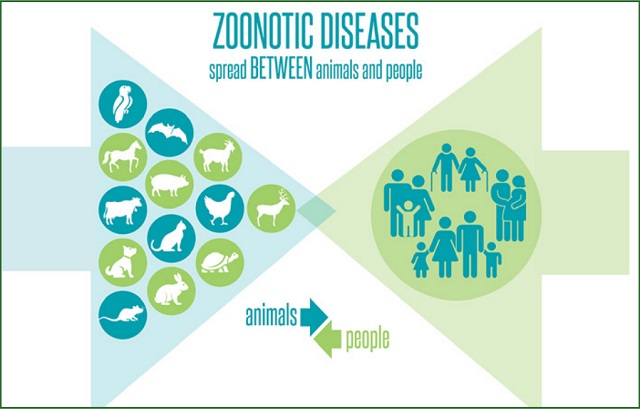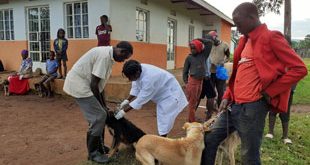
Experts blame bush meat hunting and consumption
Kampala, Uganda | PATRICIA AKANKWATSA | On September 19th, the Ministry of Health declared an Ebola Sudan outbreak in Mubende district. A sample taken from a 24-year-old man was identified as the relatively rare Sudan strain.
It is the first time in more than a decade that the Sudan strain has been found in Uganda.
Ebola, which is spread by contact with bodily fluids of an infected person or contaminated materials, manifests as a deadly hemorrhagic fever. Symptoms include fever, vomiting, diarrhoea, muscle pain and at times internal and external bleeding.
Scientists do not know the natural reservoir of the virus, but they suspect the first victim in an Ebola outbreak gets infected through contact with an infected animal which is considered a zoonotic disease.
While speaking at a webinar organised by Earth Journalism network under the theme, The Story Behind Bushmeat: The Relationship Between Rising Viral Diseases and Diminishing Animal Communities, Dr Daniel Mdetele, TRAFFIC lead on zoonotic disease risk analysis said that Zoonotic diseases are diseases that normally exist in invertebrates but can jump to infect humans during spillover events.
Zoonotic spillover has been documented as originating from various domesticated and non-domesticated wild animals.
Zoonoses have two modes of transmission, including direct zoonosis. This is when the infectious disease is directly transmitted from animals to humans through media such as air or direct contacts such as consumption or bites.
The second mode is indirect zoonosis, which happens when the infectious disease is transmitted via an intermediate species or vector that carries the pathogen without getting infected. The exact mechanism of viral spillover however remains unknown.
Dr Mdetele says that wildlife harbours zoonotic disease pathogens with no clinical illness and the spillover to livestock is amplified.
“Livestock in close contact with wildlife can serve as an intermediate of zoonotic disease transmission between wildlife and humans,”
“Livestock in close contact with wildlife can become infected with zoonotic diseases and pass onto humans as they are in close contact,” he added.
Daniel Ndizihiwe, Wildlife and Protected Areas Manager at World Wide Fund (WWF) Uganda says one of the other causes of zoonotic disease infection is bushmeat hunting and consumption.
“Families and communities frequently rely on bushmeat for food security and basic income. In Uganda, the harvest of wildlife is illegal but bushmeat hunting is common,”
“This has resulted in a covert market with person-to-person exchanges rather than legal open markets,”
He adds that depending on the wildlife species involved such as baboons, bats, hippopotami or monkeys, hunting, preparing, and consuming bushmeat has the potential to spread diseases such as the Ebola virus.
“The bushmeat trade presents numerous routes of opportunity for transmission of zoonotic pathogens, including airborne and blood-borne during hunting and the butchering of carcasses, as well as foodborne risks associated with preparation and consumption,”
Ndizihiwe also says that consumption-related risks are especially relevant in areas where there is suboptimal storage of meat in the consumer chain, allowing the proliferation of bacterial pathogens.
“Information about the effects of hunting and associated diseases remains limited largely due to poor healthcare access and reporting in many regions where bushmeat hunting and consumption are common,”
Recent epidemics have instilled zoonotic diseases into the global consciousness following large-scale and highly publicised outbreaks such as the 2015 and ongoing Ebola virus epidemics and the recent COVID-19 pandemic
According to a 2020 WHO report, zoonoses comprise a large percentage of all newly identified infectious diseases as well as many existing ones and more than 60% of human pathogens are zoonotic in origin.
Some diseases such as HIV begin as a zoonosis but later mutate into human-only strains. Other zoonoses can cause recurring disease outbreaks such as Ebola virus disease, while others, such as the novel coronavirus that causes COVID-19, have the potential to cause global pandemics, said the report.
The ongoing COVID-19 pandemic has been associated with a wildlife market in Wuhan, China. Researchers suggest that buffer zones such as tree farms or reforestation projects around biodiversity-rich forests could dramatically lessen the likelihood of human-wild primate interaction.
And the more humans and animals come into contact with each other, especially when humans eat infected animals, the more likely it is that additional diseases will emerge.
The Director General of Health Services at Uganda’s Health Ministry, Dr Henry Mwebesa, said that the Joint Risk Assessment is a milestone in implementing a One Health approach to disease prevention and management of the complex health challenges in Uganda.
“Recognising the serious consequences of emerging infectious diseases and bringing together information on humans, animals and the environment are critical in ensuring risk management decisions,” he said.
According to Lt. Col. Dr Kyobe Henry Bbosa the Incident Commander of Ebola, the virus was first suspected in early September in Mubende a small village in Madudu where there were lots of death until recently when it was confirmed.
He says that as of Sept.22, there were 7 confirmed cases, 1 death, 7 probable cases, 11 contacts and 43 untraceable cases.
****
 The Independent Uganda: You get the Truth we Pay the Price
The Independent Uganda: You get the Truth we Pay the Price


